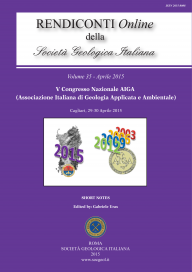
A deterministic approach for shallow landslide triggering scenarios in the southern Messina area (north-eastern Sicily, Italy)
Luca Schilirò (a), Carlo Esposito (a) & Gabriele Scarascia Mugnozza (a)
(a) Sapienza Università di Roma - Dipartimento di Scienze della Terra e Centro di Ricerca CERI, Piazzale Aldo Moro, 5, 00185, Roma, Italia. E-mail: luca.schiliro@uniroma1.it
Volume: 35/2015
Pages: 272-275
Abstract
The aim of this work is to define different triggering scenarios for shallow landslides through a physically-based approach. In particular, numerical simulations have been performed using TRIGRS model for the back-analysis of a reference landslide event, i.e. the disaster occurred in the Giampilieri area (located approximately SW of Messina in north-eastern Sicily, Italy) on October 1st, 2009. The simulation results, expressed in terms of safety factor (FS), describe a temporal evolution of the slope instability substantially consistent with the real event. With regard to the spatial distribution of the slope failures, the model is able to identify quite well the 2009 landslide phenomena, since 48.5% of the source areas and 79.8% of the stable areas are correctly classified. After the calibration of the physically-based model, different triggering scenarios have been reconstructed by varying the rainfall input, on the basis of the hourly rainfall probability curves obtained through a statistical analysis of historical rainfall data. The results indicate that even rainfalls with low return period and short duration (i.e. one hour) can produce a considerable instability level, in agree with the high number of landslide/flood events recorded in the study area since the last century.
Keywords
intense rainfall, north-eastern Sicily, return period, shallow landslides, statistical analysis, TRIGRS.
Get Full Text